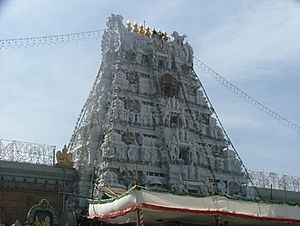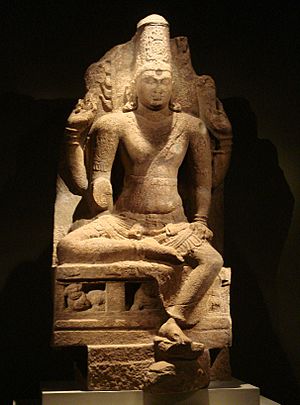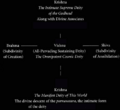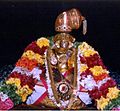Vaishnavism facts for kids
Vaishnavism (Sanskrit: वैष्णव धर्म) is a major branch of Hinduism. People who follow Vaishnavism are called Vaishnavas. They believe that Vishnu is the supreme, or highest, God. They also worship Vishnu's different forms, called avatars, especially Rama and Krishna.
Vaishnavas worship God using names like Narayana, Krishna, Vāsudeva, or simply "Vishnu." Their beliefs are based on ancient Hindu texts. These include the Upanishads, the Vedas, and Puranic texts. Important Puranic texts are the Bhagavad Gita, the Padma Purana, the Vishnu Purana, and the Bhagavata Purana. A key idea in Vaishnavism is Bhakti, which means loving devotion to God.
Many Hindus are Vaishnavas, and most of them live in India. In recent years, more and more people outside India have learned about Vaishnavism. The Gaudiya Vaishnava branch has helped spread awareness of Vaishnavism around the world. This happened a lot since the mid-1900s, thanks to groups like the Hare Krishna movement, especially ISKCON.
Contents
Who is Vishnu?
Vishnu is one of the most important gods in Hinduism. He is often seen as the preserver of the universe. This means he helps keep the world in balance and protects it from evil. Vishnu is usually shown with blue skin and four arms. Each arm holds a special item, like a conch shell, a discus, a mace, and a lotus flower.
Vishnu's Avatars
An avatar is when a god appears on Earth in a different form. Vishnu has taken many avatars to help humanity and restore goodness. Two of his most famous avatars are Rama and Krishna.
- Rama: He is the hero of the ancient epic story, the Ramayana. Rama is known for his honesty, courage, and strong sense of duty.
- Krishna: He is a central figure in the Mahabharata epic and the Bhagavad Gita. Krishna is known for his wisdom, playfulness, and divine love.
Key Beliefs and Practices
Vaishnavism focuses on a deep, loving relationship with God. This is called Bhakti.
Bhakti Yoga
Bhakti Yoga is a spiritual path where followers express their love and devotion to Vishnu or his avatars. This can be done in many ways:
- Chanting: Repeating God's names, like the Hare Krishna mantra.
- Praying: Offering prayers and asking for guidance.
- Singing: Singing devotional songs called bhajans or kirtans.
- Worship: Performing rituals and offering items like flowers and food to deities (statues or images of God).
- Serving: Helping others and doing good deeds as an act of devotion.
Important Texts
Vaishnavas study many sacred texts to understand their faith.
- The Vedas: These are the oldest and most important Hindu scriptures.
- The Upanishads: These texts contain deep philosophical ideas about the nature of reality and the soul.
- The Puranas: These are ancient stories that tell about the gods, goddesses, and heroes. The Bhagavata Purana is especially important for Vaishnavas because it tells many stories about Krishna.
- The Bhagavad Gita: This is a conversation between Krishna and the warrior Arjuna. It teaches about duty, devotion, and the path to spiritual freedom.
While Vaishnavism has been practiced in India for thousands of years, it has grown globally. The Hare Krishna movement, officially known as the ISKCON, played a big part in this. They started in the 1960s and helped introduce Vaishnava teachings and practices to people in Western countries. They built temples, shared books, and taught about Bhakti Yoga.
Today, Vaishnavism continues to be a vibrant and growing tradition, inspiring millions of people worldwide to live a life of devotion and spiritual connection.
Images for kids
See also
 In Spanish: Visnuismo para niños
In Spanish: Visnuismo para niños










